Occupational environment monitoring at the factory producing pocket computers
99,000 ₫
Note: The above price is calculated for one sample. Prices may fluctuate depending on the area of the environment to be monitored and market conditions. For more accurate pricing support, please refer to the price list or contact our consulting staff directly.
Workplace environment monitoring for a pocket computer production factory is a session of collecting, analyzing, and evaluating factors at the workplace that may be harmful to workers’ health.
Table of Contents
Toggle1. Overview of Pocket Computer Production Factories
a. What is a pocket computer production factory?
A production factory for pocket computers is an industrial facility specializing in assembling, testing, and packaging pocket computers, also called laptops or mobile computers. This factory has a production process designed specifically for mass-producing pocket computers with high quality and performance.
The production process in this factory may vary depending on the specific company and technology used, but the steps listed below are usually the main stages to produce high-quality pocket computers that meet market demand.

b. Production stages in a pocket computer production factory
The production stages in a pocket computer (laptop) production factory may include:
- Manufacturing the casing and frame: This process includes machining and molding parts such as the casing, hinges, frame, and other peripheral components. Materials like aluminum alloy, composite plastics, and carbon fiber may be used to create lightweight and durable casings.
- Motherboard assembly: Motherboards contain important components such as the processor, memory, graphics chip, and other electronic components. This stage involves placing components onto the motherboard and soldering them into position.
- Screen and keyboard assembly: The screen and keyboard are installed into the casing through connectors and screws. This includes installing screen modules, screen cables, and the keyboard.
- Installing hard drives and other components: Hard drives, optical drives (if available), batteries, network cards, and other components are installed in their proper positions within the computer.
- Quality control and functional testing: Pocket computers are inspected to ensure that all functions work correctly and meet quality standards. Tests include performance tests, screen tests, sound tests, network connectivity tests, and more.
- Operating system and software installation: Pocket computers are installed with an operating system (e.g., Windows, macOS, or Linux) along with basic software such as web browsers, office software, and supporting applications.

c. Types of machinery used in a pocket computer production factory
In a pocket computer production factory, various types of machinery and equipment are used to carry out production and assembly stages. Some common machines used in the production process include:
- CNC machining machines: Used to process metal components such as the casing, frame, hinges, and other peripheral components. CNC machines are highly precise and automated.
- Molding machines: Used to create plastic components in the injection molding process. These machines produce plastic parts such as casings, keys, and other components.
- Soldering machines: Used to solder metal components such as motherboards, frames, and electronic connections. Soldering methods may include spot soldering, wave soldering, or TIG soldering.
- Automatic component placement machines: Used to automatically place components onto motherboards. These machines can recognize and position components with high accuracy, increasing production efficiency and assembly quality.
- Quality inspection machines: Used to test the functions and performance of pocket computers after assembly. These machines can perform screen tests, audio tests, network connectivity tests, and system operation checks.
- Operating system and software installation machines: Used to install operating systems and necessary software onto pocket computers. These machines can automatically install and configure software quickly and reliably.

d. Occupational diseases that workers in pocket computer production factories may face
Workers in pocket computer production factories may be exposed to several environmental factors that can cause health issues and occupational diseases. Some possible occupational diseases include:
- Noise-related diseases: Noise from machinery and production processes can cause early hearing loss, auditory disorders, and other ear-related issues.
- Dust-related diseases: Pocket computer production may generate dust from metal machining, soldering, and coating processes. Long-term exposure to metal dust and chemicals can cause lung disease, respiratory problems, and skin issues.
- Chemical-related diseases: Use of chemicals during production can affect respiratory health, skin, and eyes. Chemicals such as solvents, cleaning agents, sealants, and antioxidants may have negative health impacts.
- Ergonomic-related diseases: Working in uncomfortable or improper postures can cause musculoskeletal problems, spine issues, and other physical discomforts.
- Light-related diseases: Exposure to strong or ultraviolet light can lead to eye irritation, eye strain, and other vision problems.
To reduce the risk of occupational diseases, protective measures should be implemented, including using personal protective equipment, maintaining workplace hygiene, limiting exposure to harmful factors, and providing workers with training on occupational safety and health.

2. Overview of occupational environmental monitoring services
a. What is occupational environmental monitoring at a pocket computer production factory?
Occupational environmental monitoring (or workplace environment measurement) at a pocket computer production factory involves collecting, evaluating, and analyzing measurement indicators of workplace environmental factors. The goal is to implement timely measures to reduce environmental hazards to workers’ health and prevent occupational diseases. Occupational environmental monitoring is mandatory for pocket computer production factories.
Occupational environmental monitoring plays a crucial role in protecting and enhancing workers’ health because workers are the main resource and directly generate profit for the enterprise. Workers regularly exposed to risk factors exceeding permissible limits may experience health effects and develop occupational diseases.
REGISTER FOR OCCUPATIONAL ENVIRONMENTAL MONITORING SERVICE
b. An Toan Nam Viet’s occupational environmental monitoring program
An Toan Nam Viet’s occupational environmental monitoring program is developed by monitoring engineers in the fields of occupational safety and environmental protection. With the goal of ensuring workers’ health and safety, this program uses modern measurement methods to monitor air quality, water quality, and microclimate, physical, and dust factors in the workplace. This program is essential for ensuring a safe working environment and protecting workers’ health.
Additionally, An Toan Nam Viet’s monitoring program plays an important role in researching and developing new solutions to improve workplace environmental quality. With the dedication and professionalism of the monitoring team, An Toan Nam Viet’s exclusive program has become a breakthrough in occupational safety management and environmental protection in Vietnam.

c. Standardization in occupational environmental measurement procedures
Standardization in An Toan Nam Viet’s occupational environmental measurement procedures is crucial for ensuring measurement quality. To ensure accuracy and reliability, the program follows standards recognized by the Ho Chi Minh City Department of Health. This ensures that the collected data is highly reliable for evaluating the workplace environment and making decisions to improve it and protect workers’ health.
These standardized procedures also ensure that measurements are carried out by highly qualified monitoring specialists with years of experience, enabling managers and experts to trust An Toan Nam Viet’s results and make accurate, valuable decisions to protect workers and the environment.
By applying standardized procedures, An Toan Nam Viet demonstrates its commitment to ensuring a safe working environment and protecting workers’ health while contributing to the improvement of occupational safety and environmental management in Vietnam.
d. Reporting results of occupational environmental monitoring in pocket computer production factories
Occupational environmental monitoring results are prepared according to Form No. 04, Appendix III issued with Decree 44/2016/ND-CP and prepared in two copies: one sent to the contracting enterprise and one kept by the monitoring organization.
The retention period for occupational environmental monitoring results is indefinite, as required by law.

e. Frequency of occupational environmental monitoring according to law
According to Clause 2 of Article 18 of the Law on Occupational Safety and Health 84/2015/QH13, employers must organize occupational environmental monitoring at least once a year.
f. Deadline for submitting occupational environmental monitoring reports according to law
The submission deadline is before December 31 each year. Enterprises operating production facilities must submit occupational environmental monitoring reports to the local Department of Health at the location of the enterprise headquarters and where workers are employed.
If there are changes in technology, production processes, or upgrades that may generate new harmful factors affecting workers’ health, enterprises must update occupational hygiene records regarding harmful factors and conduct monitoring.
g. Penalties for violations of occupational environmental monitoring for employers
According to Article 27 of Decree No. 12/2022/ND-CP dated January 17, 2022:
- Clause 2: Fines of VND 2,000,000 – 5,000,000 for employers who fail to publicly disclose monitoring results at the workplace and where hazardous factors are evaluated immediately after receiving monitoring results and hazard management inspections.
- Clause 3: Fines of VND 20,000,000 – 40,000,000 for employers who fail to conduct occupational environmental monitoring as required by law.
- Clause 4: Fines of VND 40,000,000 – 60,000,000 for employers who collude with monitoring organizations to falsify monitoring activities but do not reach the level of criminal liability.
3. Harmful environmental factors for workers in pocket calculator factories
There are several harmful environmental factors that may exist in pocket calculator factories and can affect workers’ health. Here are some typical environmental factors:
- Noise: During pocket calculator production, machinery and equipment can generate high noise levels. Continuous and intense noise can cause stress, insomnia, reduced concentration, and negatively impact workers’ nervous system.
- Dust and fine particles: Processes such as machining, cutting, grinding, and soldering can generate dust and fine particles. If not properly controlled, these particles can cause respiratory irritation, rhinitis, pneumonia, and other health issues.
- Chemicals: Certain chemicals used in pocket calculator production can be hazardous to workers’ health. For example, solvents, cleaners, coatings, sealants, and flame retardants can irritate the skin, eyes, and respiratory system, with potential long-term health effects.
- Static electricity: During production, static electricity can occur due to movement of machinery parts and materials. Static discharge can cause shocks, equipment malfunctions, and disrupt the operation of electronic devices.
- Temperature and humidity: Some production processes may create high temperature or high humidity conditions. Uncomfortable environmental conditions can cause discomfort, fatigue, and reduce workers’ productivity.
REGISTER FOR OCCUPATIONAL ENVIRONMENT MONITORING SERVICE
4. Measures to improve working conditions in pocket calculator factories
Improving working conditions in pocket calculator factories is crucial to protect workers’ health and safety. The following measures can be applied:
- Noise management: Use noise-reducing equipment, provide protective ear devices for workers, and periodically inspect and maintain equipment to reduce noise to safe levels.
- Control dust and fine particles: Provide efficient dust extraction systems, ensure the use of personal protective equipment such as masks and goggles, and regularly clean work areas to reduce dust and fine particles.
- Chemical management: Use safe and environmentally friendly chemicals, ensure proper ventilation in the workshop, and provide personal protective equipment such as gloves, chemical-resistant clothing, and safety goggles.
- Static control: Implement anti-static measures such as conductive surfaces and ensure correct techniques in installation and operation of equipment.
- Temperature and humidity adjustment: Ensure air conditioning systems work properly and provide a comfortable working space with appropriate temperature and humidity levels.
- Training and education: Provide occupational safety training and proper use of personal protective equipment, ensuring staff understand and comply with safety regulations and procedures.
- Assessment and monitoring: Conduct occupational environment risk assessments, regularly monitor harmful environmental factors, inspect and maintain equipment, and propose improvements when necessary.
- Periodically conduct occupational environment monitoring in factories, collecting and analyzing harmful factors to adjust measures and prevent occupational diseases for workers.
5. Benefits of periodic monitoring in pocket calculator factories
An Toan Nam Viet provides businesses with excellent advantages when using occupational environment monitoring services in accordance with Decree 44/2016/ND-CP on managing and controlling harmful factors in the workplace affecting workers.
- Businesses can proactively control harmful factors in workshops or factories.
- Receive recommendations to minimize harmful factors and improve workplace quality.
- Indirectly protect human resources, a key factor in business development.
- Reduce the impact of occupational diseases on health, minimizing future treatment costs.
- Improved worker health enhances product quality and maintains consistent output.
- Ensure compliance with labor safety laws and avoid legal risks.
- Build credibility and professionalism, elevating the company’s brand.
Nam Viet’s environmental monitoring service is a solution to mitigate occupational disease risks, contributing to a clean and high-quality working environment.

6. National occupational environment monitoring center
Occupational Environment Monitoring Center of Nam Viet is a professional unit specializing in supervising and measuring workplace environmental quality across all provinces in Vietnam. With a team of experienced monitoring specialists, the center uses modern measurement equipment to ensure accuracy and reliability.
Besides monitoring services, the center assists clients in planning, managing, and tracking occupational environmental issues. Following the motto “customer-centered,” the center prioritizes customer satisfaction, meets all needs, and provides the best solutions for businesses.
REGISTER FOR OCCUPATIONAL ENVIRONMENT MONITORING SERVICE
With investments in technology, equipment, and human resources, Nam Viet’s monitoring center has become a reputable unit in occupational environment monitoring in Ho Chi Minh City, with the following objectives:
- We always value our brand reputation and service quality.
- We provide clients with the best and most suitable solutions possible.
- With a team of experienced Masters and Engineers dedicated to environmental protection and business benefits.
- By choosing Nam Viet Environmental Monitoring, companies receive professional service from experts and cost advantages.
The occupational environment monitoring process at Nam Viet includes the following basic steps:
- Before monitoring, the company ensures all equipment is calibrated according to legal regulations.
- Follow the occupational environment monitoring procedures accurately as committed to the Department of Health.
- Report monitoring results honestly to employers.
- If monitoring results indicate unsafe conditions, Nam Viet provides corrective solutions, and the workplace implements the following:
- Implement measures to improve working conditions, minimize harmful factor impacts, and prevent occupational diseases.
- Conduct health examinations to detect occupational and related diseases early for workers in unsafe environments.
- Provide in-kind compensation to workers according to labor law.

7. Occupational environment monitoring quotation
To help businesses conduct professional and effective occupational environment monitoring, Nam Viet provides clients with a quotation for occupational environment monitoring services that is high-quality and reasonably priced.
- Our quotation provides detailed pricing information for the monitoring services we offer, including costs related to travel, measurement, analysis, and reporting. Clients can trust the accuracy and reliability of our monitoring reports.
- We commit to offering competitive and reasonable prices in the market and are always ready to provide prompt and professional consultation on any monitoring service inquiries.
- With Nam Viet’s quotation, clients can easily select service packages that suit their needs. We are committed to delivering the highest satisfaction with professional service quality.
No comments yet

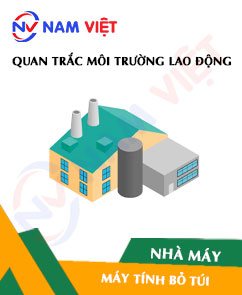
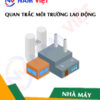
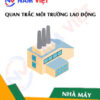



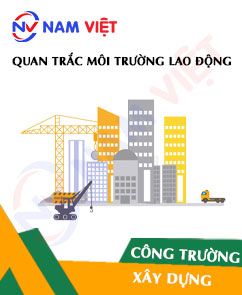
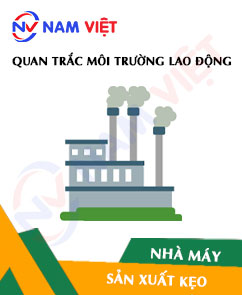

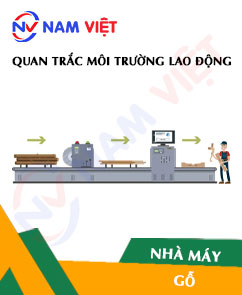

Review Occupational environment monitoring at the factory producing pocket computers
There are no reviews yet.